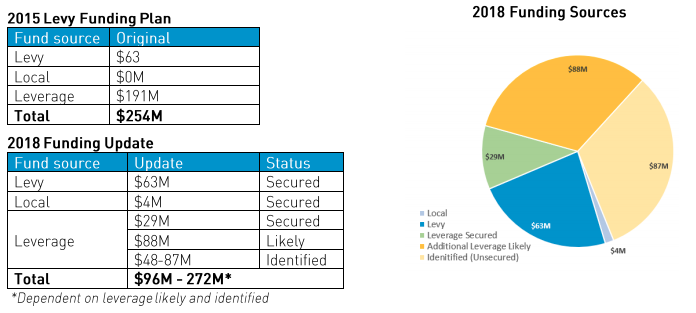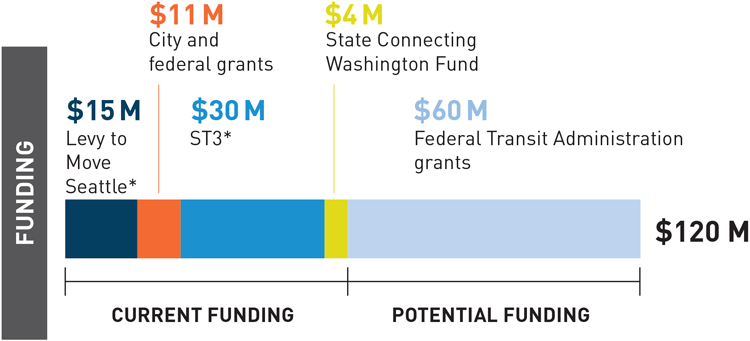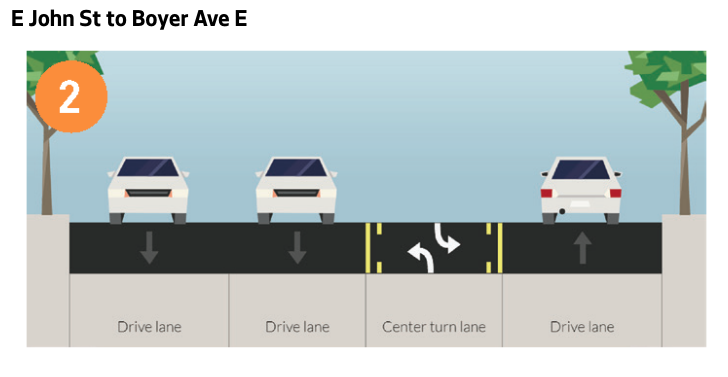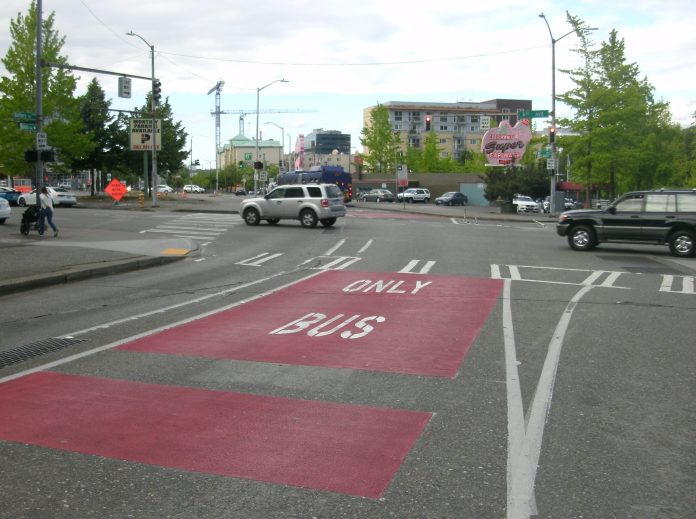$96 million dollars could be the new overall budget cap for all seven corridors that the Seattle Department of Transportation (SDOT) promised voters it would upgrade to prioritize transit, according to the newly released findings from the reassessment of the nine-year Move Seattle levy that has been taking place over the past few months. That’s down from an original estimated budget of $254 million, and could mean a dramatic scaling back in both the scope and planned timelines for most of the projects.

The main cause in this huge difference was a heavy dependence on federal grant funds in the original levy budget, made at a time when grants were doled out much more quickly and when Seattle had been receiving a record amount of federal dollars for its projects, according to SDOT staff.
When talking about these projects, I am going to avoid using the word RapidRide, as SDOT staff, presenting a status update to the Transit Advisory Board last week, were careful to point out that the Move Seattle ballot language does not use the word either. To fulfill the promises made in the ballot measure, Seattle needs only to make investments that improve transit service on seven corridors. Whether those become official RapidRide lines is up to King County Metro Transit, which will be utilizing county funds to make an estimated $576 million in investments on all of its planned countywide RapidRide lines.
The Madison corridor project, the centerpiece and most expensive among the seven, is still waiting on the approval of a $60 million Small Starts grant. The project has already had its estimated completion date pushed back to 2021 and without that grant significant components of the project will have to be reassessed. Its total budget of $120 million is more than the possible new budget floor for the entire transit corridor improvement program: $15 million is needed just to purchase rights-of-way and the special trolleybus fleet with left-side doors that are needed for the center-loading platforms along the First Hill segment of the corridor. $15 million is also the entire contribution from the Move Seattle levy itself. It could be late 2018 until we find out if we do receive the federal grant. The Madison project would be the only transit project in First Hill planned with dedicated right-of-way for decades.

The Roosevelt transit line, not as far along in planning as Madison, is also in the queue for Small Starts grants to cover half of the estimated project cost of $77 million, with just under $14 million coming from Move Seattle funds. The bike lane component of Roosevelt, one of its main selling points for a corridor that has long been unsafe for cyclists and low on transit ridership, has faced opposition from Eastlake residents wary of losing on-street parking. Even if the Small Starts grants do come through, improvements on the remaining five corridors will either need to be funded through additional grants or they will be paltry by comparison.
With all of these federal dollars delayed and possibly nonexistent, SDOT is trying to tamp down expectations around these corridors, stating that “community expectations” around the corridor improvements include things that are not in the scope of the budget for the projects. This will be familiar to anyone who has been following the Madison project since its early planning stages–when it was billed as full-bore bus rapid transit. Originally, “parallel” bike infrastructure improvements on nearby streets, including protected bike lanes on E Union St, were included in the plan as part of complete streets upgrades. As design moved along, advocates were surprised to learn that the protected bike lanes were “out of scope” for the project, in other words they would add too much to the cost. After a vocal response to this news, the department responded by adding them back into the bike master plan budget, not the Madison project budget. Suffice it to say that adding projects onto the bike master plan is not likely to remain a strategy given the budget problems in that subprogram.
With limited funding, the transit corridor improvement program is likely to become a glorified spot improvement fund. In addition, the department will be going out into the neighborhoods adjacent to the corridors impacted and asking residents to prioritize what should be done with limited funds. While different neighborhoods might in fact prioritize different aspects of a project in ways that are all legitimate, it’s worth asking whether deprioritizing improvements that would further Seattle’s citywide goals of reduced private vehicle use and eliminating serious and fatal traffic injuries is acceptable. In short, it is absolutely not.

23rd Avenue is the last planned transit corridor to be funded through Move Seattle, with a current estimated completion date of 2024. However, improvements around street maintenance on that corridor are moving into their final phase and the department has jettisoned both transit priority and any significant traffic calming improvements in the name of safety, all the while citing community feedback as the basis for its decisions. The project website for the 23rd Avenue safety project states: “Note that while our preliminary design included one northbound general purpose lane and one northbound transit lane, we’ve decided to remove the transit lane and replace it with a second northbound general purpose lane based on community feedback.” This does not bode well for prioritization of limited funds.
While leadership on transit and active transportation issues is lacking from the mayor’s office, Seattle will in fact need to make some big decisions around what to do with limited funds for transit. This week, the Lander Street overpass starts construction, the biggest single use of Move Seattle funds over the nine-year life of the levy. But the projects that will truly make Seattle a safer, climate resilient, transit rich city are in danger of being deprioritized due to lack of funds. We can’t allow that to happen, so now is the time to make our voices heard. Additional funds must be found to deliver the promises made to voters at the ballot box, and safety and transit priority must be made the most important uses of those funds.
This is the third in a series on budget updates to the Move Seattle levy in 2018. See part one on the bike master plan and part two on the pedestrian master plan.
Ryan Packer has been writing for The Urbanist since 2015, and currently reports full-time as Contributing Editor. Their beats are transportation, land use, public space, traffic safety, and obscure community meetings. Packer has also reported for other regional outlets including BikePortland, Seattle Met, and PubliCola. They live in the Capitol Hill neighborhood of Seattle.


